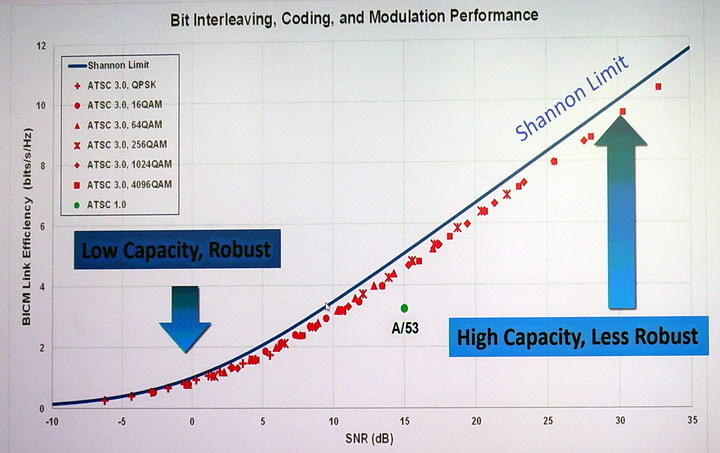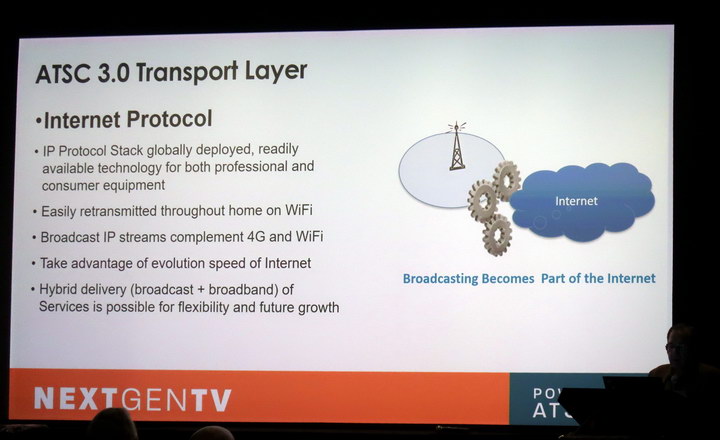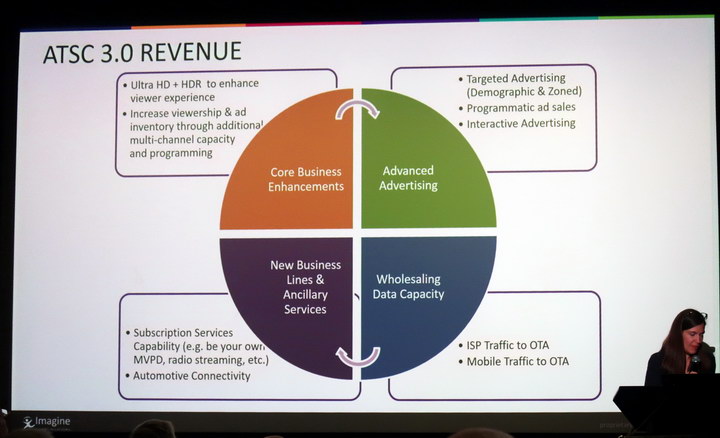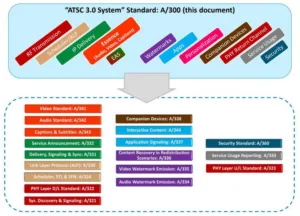5G isn’t the only new communications format in your future: ATSC 3.0 is coming in the US, if its advocates have their way.

In my last DD, titled Boundless Enthusiasm for 5G NR, I looked at the upcoming deployment of 5G cellular technology, especially deployments based on the 5G NR standard. The piggyback 5G standard for areas with existing 4G LTE infrastructure was approved in December 2017 and the standalone standard (5G NR) for areas without this infrastructure was approved in June 2018. The ATSC 3.0 suite of 20 standards has also been approved in the same time frame and its advocates are ready to roll it out. PDF versions of all of these standards can be downloaded for free from the ATSC website.
- A/300:2017, “ATSC 3.0 System” Approved 19 October 2017
- A/321:2016, “System Discovery and Signaling” Approved 23 March 2016
- A/322:2017, “Physical Layer Protocol” Approved 6 June 2017
- A/324:2018, “Scheduler / Studio to Transmitter Link” Approved 5 January 2018
- A/330:2016, “Link-Layer Protocol” Approved 19 September 2016
- A/331:2017, “Signaling, Delivery, Synchronization, and Error Protection” Approved 6 December 2017
- A/332:2017, “Service Announcement” Approved 6 December 2017
- A/333:2017, “Service Usage Reporting” Approved 4 January 2017
- A/334:2016, “Audio Watermark Emission” Approved 19 September 2016
- A/335:2016 “Video Watermark Emission” Approved 20 September 2016
- A/336:2018, “Content Recovery in Redistribution Scenarios” Approved 24 April 2018.
- A/337:2018, “Application Signaling” Approved 2 January 2018
- A/338:2017, “Companion Device” Approved 17 April 2017
- A/341:2018, “VIDEO – HEVC” Approved 28 August 2018.
- A/342 Part 1:2017, “Audio Common Elements” Approved 24 January 2017
- A/342 Part 2:2017, “AC-4 System” Approved 23 February 2017
- A/342 Part 3:2017, “MPEG-H System” Approved 3 March 2017
- A/343:2017, “Captions and Subtitles” Approved 18 September 2017
- A/344:2017, “ATSC 3.0 Interactive Content” Approved 18 December 2017
- A/360:2018, “ATSC 3.0 Security and Service Protection” Approved 9 January 2018
This suite of 20 related standards is intended to be complete. While the standards may be updated, a 21st member of the family is not expected.
ATSC 3.0 standards set and structure (Credit: ATSC. Figure 5.1 from A/300:2017. Click for higher resolution)
On September 5th, the New York Chapter of SMPTE had a well-attended meeting dedicated to ATSC 3.0. There were two speakers, Merrill Weiss, Owner, Merrill Weiss Group LLC and Sarah Foss, SVP & GM, Imagine Communications Ad Tech. Mr. Weiss not only helped develop the ATSC 3.0 standards, while at NBC he helped to develop the ATSC 1.0 standard. While he has five patents related to digital TV, his education was at the Warton School and his corporate experience is in the management of technology, not the technology itself. His talk covered the technology of ATSC 3.0 and he drew heavily from the published standards. Ms. Foss is an advertising person, not a technical person. She talked about (with great enthusiasm) the business aspects of ATSC 3.0, with special emphasis on the additional advertising revenue streams that ATSC 3.0 will enable for the broadcasters.
 Bit rates and signal robustness for ATSC 1.0 and 3.0 (Credit: Merrill Weiss)
Bit rates and signal robustness for ATSC 1.0 and 3.0 (Credit: Merrill Weiss)
The basic design of ATSC 3.0 has not changed since I last wrote a Display Daily on the topic in January, 2016, so I won’t go into too much detail on the technology. The ATSC 3.0 RF encoding method is OFDM, QAM and QPSK compared to 8VSB used by ATSC 1.0. One of the problems with 8VSB is its poor performance with mobile receivers – not just cars but smartphones, too. While the 8VSB system was fixed for ATSC 1.0, providing about 3 bits/hertz of bandwidth, ATSC 3.0 will be able to dynamically change its encoding scheme. This will allow portions of the ATSC 3.0 signal to be sent very robustly so it is always received and other portions of the signal to be sent with higher bit rates, although these portions of the signal may not be received correctly in noisy or low-signal environments.
Weiss said the Bootstrap portion of the signal, in particular, is sent in a very robust form. He says that any receiver that gets any signal will be able to decode the Bootstrap, even if the rest of the signal is lost. Another example of this feature will be for basic, low resolution images to be sent with high robustness and low bit rates and the enhancement data to turn the image into a HD or UHD image send with reduced robustness and a higher bit rate. This will help ensure mobile receivers always get at least the basic video signal.
Single Frequency Networks (SFNs), while used in ATSC 1.0, will work better in 3.0 and are expected to become more common. Traditionally, a broadcaster has a broadcast tower somewhere for his transmitter – one tower and one transmitter. Under both ATSC 1.0 and 3.0, the FCC will allow a broadcaster to have multiple towers all broadcasting on the same radio frequency and with overlapping coverage. This allows a broadcaster, for example, to put a tower on the other side of a mountain to provide better coverage in that region.
One would expect, however, the two (or more) towers broadcasting on the same frequency would interfere with each other and confuse the digital receiver. ATSC uses the Ghost Cancelation technology, originally developed to eliminate ghosts in analog transmissions caused by reflections off of large buildings, to combine the two signals into one strong, unambiguous signal. This feature was added to ATSC 1.0 more or less as an afterthought, although Mr. Weiss said there are 17 broadcasters in the US with ATSC 1.0 SFNs. ATSC 3.0 was designed with SFNs in mind and he expects there will be many more.
One key question is about the ATSC 1.0 to 3.0 transition. This transition is not trivial because ATSC 3.0 is not backward compatible with ATSC 1.0 The millions of TVs with ATSC 1.0 tuners will not be able to receive ATSC 3.0 signals without an external converter box. It has always been expected that the FCC will not:
- mandate the conversion to ATSC 3.0;
- provide a second frequency to a broadcaster for use during the transition period; or
- finance converter boxes for end users, the way it did during the analog NTSC to digital ATSC conversion.
Instead, the FCC has mandated that the main broadcast content be simulcast for five years on both ATSC 1.0 and 3.0 after a station converts to 3.0. Since both ATSC 1.0 and 3.0 are capable of transmitting more than one video signal, this can be done by two stations in the same area pairing together. The first station will continue broadcast in ATSC 1.0 and will broadcast both its own content and the content of the second station. The second station will convert to ATSC 3.0 and also broadcast the content for both stations, as well as additional content enabled by the ATSC 3.0 format.
This additional content is actually quite significant because 3.0 has a much higher bit rate than 1.0, even on the same frequency and bandwidth. In fact, ATSC 3.0 was designed to be more “Internet-like” and is able to target some content (i.e. ads) at specific demographics and other ads at the same time at another demographic. If you are a young woman, you won’t see ads for geriatric medicine and if you’re an old man, you won’t see ads for spring break cruises.
 ATSC 3.0 is based on IP and HTML-5 (Credit: Merrill Weiss)
ATSC 3.0 is based on IP and HTML-5 (Credit: Merrill Weiss)
ATSC 3.0 is designed to work with the Internet, which will provide a back-channel from the TV to the broadcaster for interactive content and other purposes. One of these other purposes is to provide the broadcaster directly with data on who is watching his shows, without the need to depend on third-party sources of this information such as Nielsen. Another use of the Internet for ATSC 3.0 is providing content in multiple languages. The broadcast version of the content will include one or a few languages, for example English or English and Spanish. The broadcaster can send as many additional languages as he chooses to the TV via the Internet and still expect good lip-sync when the content is shown.
 Sarah Foss explaining the additional revenue streams for broadcasters enabled by ATSC 3.0. (Credit: Sarah Foss, Imagine Communications)
Sarah Foss explaining the additional revenue streams for broadcasters enabled by ATSC 3.0. (Credit: Sarah Foss, Imagine Communications)
Foss emphasized the business aspects of ATSC 3.0 and the new advertising and subscription revenue streams enabled by the technology. She said that for ATSC 1.0, the heavy lifting was on the technology side of the system. For ATSC 3.0, digital broadcast technology and Internet technology is much better understood and the heavy lifting was on the business side, to make the format better for broadcasters. Multiple ads can be carried simultaneously and the ad shown on a particular TV can be controlled based on location, demographics or other criterion.
For example, an automobile dealer based on Long Island could place an ad on a New York-based broadcast that targets only Long Island. The broadcaster could sell separately the same ad time slot to a New Jersey-based car dealer that will only be seen in New Jersey. Since ATSC 3.0 is expected to work much better with mobile screens, the total audience will be increased as well. To demonstrate this, a driverless bus (Subscription required) was used at NAB this year to demonstrate live, mobile ATSC 3.0 broadcasts.
In the Q&A session following their talks, neither speaker was concerned about the inability of any TV or any STB now on the market to receive ATSC 3.0 signals. They believed that the cord-cutting trend, especially among millennials, was so strong that they would be willing to buy external STBs to receive these signals. Since the ATSC 3.0 transport stream is based on Internet Protocol and HTML-5, it will provide cord-cutters with a very familiar environment.
In general, the corporate effort going into ATSC 3.0 is at nowhere near the level of effort going into 5G. For example, since January 1, 2018, there have been 1715 press releases that reference “5G” posted on Business Wire while in the same time frame, there have only been 26 press releases that mention “ATSC.” Some of these ATSC releases deal, in fact, with ATSC 1.0, not 3.0. The 5G press releases are in multiple languages and come from virtually everyone involved in mobile communications, including standards organizations, consulting firms, system operators, chip suppliers and phone manufacturers. The ATSC 3.0-related press releases mostly come from standards bodies and consulting firms who want to educate the technical community on the future of broadcast TV. Tellingly, not one of the 26 ATSC press releases was from a chip manufacturer announcing their ATSC 3.0 decoder chip.
 Verizon two-page ad in the New York Times on September 17, 2018 telling the general public about the coming of Verizon 5G.
Verizon two-page ad in the New York Times on September 17, 2018 telling the general public about the coming of Verizon 5G.
While there are plenty of consultants to tell the wireless communication community about 5G, most people in the business already know something about it. As can be seen in the image, at least one service provider, Verizon, is focusing efforts on telling the general public about the coming of 5G.
The ATSC 1.0 to 3.0 conversion is probably coming, although it is probably not coming as fast as enthusiasts like Weiss or Foss would like to see it come. Some 5G enthusiasts don’t see a future for broadcast at all – the ultra-high bandwidth of 5G could make broadcasters obsolete. At the very least, the ATSC 1.0 to 3.0 conversion can’t come until there are viewers with the ability to view ATSC 3.0 broadcasts. This can’t happen until the chip makers make a ATSC 3.0 decoder chip or chipset. While this may be happening behind closed doors at the chip designers, there is no sign of the bounty of chips that is available to phone designers who want to incorporate 5G into their products. –Matthew Brennesholtz
Analyst Comment
After I’d done my press release count on September 17th, one more 5G announcement came out later that day and caught my eye. It was from Samsung and titled “Samsung Selected To Supply 5G NR Solution by SK Telecom,” subtitled “Companies to begin the commercial deployments in Korea this October.” Enough Said. MB
As we have previously reported, all of LG’s UltraHD TV sets in Korea in 2018 have support for ATSC 3.0 as that country is adopting the technology. At press time, we hadn’t been able to confirm the scale of the roll out of ATSC 3.0 in Korea – if readers have knowledge in this area, please let me know. (BR)

